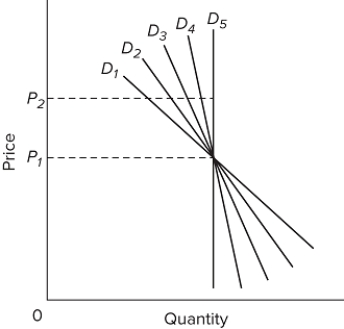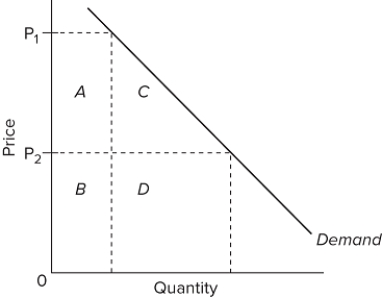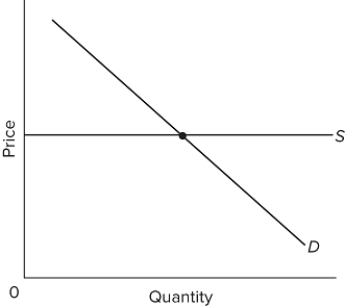A) has declined.
B) is of unit elasticity.
C) is inelastic.
D) is elastic.
Correct Answer

verified
Correct Answer
verified
Multiple Choice
If the government imposes an excise tax on a good, it will collect the most tax revenues from it if the demand for the good is
A) elastic.
B) inelastic.
C) unit elastic.
D) perfectly elastic.
Correct Answer

verified
Correct Answer
verified
Multiple Choice
 Refer to the graph above. Which demand curve is relatively most elastic between P₁ and P₂?
Refer to the graph above. Which demand curve is relatively most elastic between P₁ and P₂?
A) D₁
B) D₂
C) D₃
D) D₄
Correct Answer

verified
Correct Answer
verified
Multiple Choice
The price elasticity of demand is a measure of the
A) effect of changes in demand on the price.
B) relationship between price and profitability.
C) responsiveness of buyers of a good to changes in its price.
D) sensitivity of a good's price to changes in demand.
Correct Answer

verified
Correct Answer
verified
Multiple Choice
Which of the following is not characteristic of the demand for a commodity that is elastic?
A) The relative change in quantity demanded is greater than the relative change in price.
B) Buyers are relatively sensitive to price changes.
C) Total revenue increases if price is increased.
D) The elasticity coefficient is greater than one.
Correct Answer

verified
Correct Answer
verified
Multiple Choice
The demand for a necessity whose cost is a small portion of one's total income is
A) perfectly price inelastic.
B) perfectly price elastic.
C) relatively price inelastic.
D) relatively price elastic.
Correct Answer

verified
Correct Answer
verified
Multiple Choice
 Refer to the diagram. The decline in price from P₁ to P₂ will
Refer to the diagram. The decline in price from P₁ to P₂ will
A) increase total revenue by D.
B) increase total revenue by B + D.
C) decrease total revenue by A.
D) increase total revenue by D − A.
Correct Answer

verified
Correct Answer
verified
Multiple Choice
Suppose the price elasticity of supply for crude oil is 0.6. How much would price have to rise to increase production by 12 percent?
A) 20 percent
B) 7.2 percent
C) 12 percent
D) 15 percent
Correct Answer

verified
Correct Answer
verified
Multiple Choice
Which of the following goods (with their respective income elasticity coefficients in parentheses) will most likely suffer a decline in demand during a recession?
A) dinner at a nice restaurant (+1.8)
B) chicken purchased at the grocery store for preparation at home (+0.25)
C) second-hand clothing (-0.6)
D) plasma screen and LCD TVs (+4.2)
Correct Answer

verified
Correct Answer
verified
Multiple Choice
A state government wants to increase the taxes on cigarettes to increase tax revenue. Because cigarettes are addictive, we would expect its demand to be
A) elastic. Thus, the government's cigarette-tax revenues would rise with a tax increase.
B) elastic. Thus, the government's cigarette-tax revenues would fall with a tax increase.
C) inelastic. Thus, the government's cigarette-tax revenues would fall with a tax increase.
D) inelastic. Thus, the government's cigarette-tax revenues would rise with a tax increase.
Correct Answer

verified
Correct Answer
verified
Multiple Choice
Price elasticity of demand is generally
A) greater in the long run than in the short run.
B) greater in the short run than in the long run.
C) the same in both the short run and the long run.
D) greater for "necessities" than it is for "luxuries."
Correct Answer

verified
Correct Answer
verified
Multiple Choice
A perfectly inelastic demand schedule
A) rises upward and to the right but has a constant slope.
B) can be represented by a line parallel to the vertical axis.
C) cannot be shown on a two-dimensional graph.
D) can be represented by a line parallel to the horizontal axis.
Correct Answer

verified
Correct Answer
verified
Multiple Choice
 Refer to the above graph. Which of the following statements is correct?
Refer to the above graph. Which of the following statements is correct?
A) Demand is perfectly elastic.
B) Demand is perfectly inelastic.
C) Supply is perfectly elastic.
D) Supply is perfectly inelastic.
Correct Answer

verified
Correct Answer
verified
Multiple Choice
If an increase in the supply of a product in the market results in a decrease in price, but no change in the quantity traded, then
A) the price elasticity of supply is zero.
B) the price elasticity of supply is infinite.
C) the price elasticity of demand is unitary.
D) the price elasticity of demand is zero.
Correct Answer

verified
Correct Answer
verified
Multiple Choice
Answer the question on the basis of the following demand schedule.  The price elasticity of demand is relatively inelastic
The price elasticity of demand is relatively inelastic
A) in the $6-$4 price range.
B) over the entire $6-$1 price range.
C) in the $3-$1 price range.
D) in the $6-$5 price range only.
Correct Answer

verified
Correct Answer
verified
Multiple Choice
The supply curve of a one-of-a-kind original painting is
A) relatively elastic.
B) relatively inelastic.
C) perfectly inelastic.
D) perfectly elastic.
Correct Answer

verified
Correct Answer
verified
Multiple Choice
A negative income elasticity of demand coefficient indicates that
A) the product is an inferior good.
B) the product follows the law of demand.
C) the product is a complementary good.
D) the product is a substitute good.
Correct Answer

verified
Correct Answer
verified
True/False
A linear demand curve has a constant elasticity over the full range of the curve.
Correct Answer

verified
Correct Answer
verified
Multiple Choice
Airlines charge business travelers more than leisure travelers because there is a more
A) elastic supply of business travel.
B) inelastic supply of business travel.
C) elastic demand for business travel.
D) inelastic demand for business travel.
Correct Answer

verified
Correct Answer
verified
Multiple Choice
The concept of price elasticity of demand measures
A) the slope of the demand curve.
B) the number of buyers in a market.
C) the extent to which the demand curve shifts as the result of a price decline.
D) the sensitivity of consumer purchases to price changes.
Correct Answer

verified
Correct Answer
verified
Showing 161 - 180 of 399
Related Exams